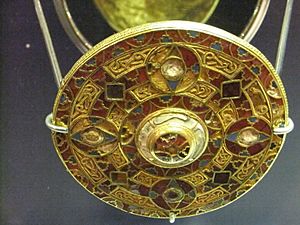Bryan Faussett facts for kids
Bryan Faussett (born October 30, 1720 – died February 20, 1776) was an English expert in old things, known as an antiquary. He loved to find and collect ancient objects. Faussett built up a huge collection, especially rich in items from the Anglo-Saxon period. These included personal decorations like pendants, brooches, beads, and buckles.
One of his most famous finds was the Kingston Brooch. This is the largest known Anglo-Saxon brooch made from different parts. When he died, Bryan Faussett had the biggest collection of Anglo-Saxon items in the world.
After his death, his collection was shown to the public in 1844 by the British Archaeological Association. Later, in 1853, over five thousand of his Roman and English coins were sold. In 1855, a collector named Joseph Mayer bought his main collection. Today, you can see these amazing objects at the World Museum in Liverpool. Faussett is remembered as a pioneer because he kept such detailed records of his archaeological discoveries.
Contents
Early Life and School
Bryan Faussett was born on October 30, 1720, in Heppington, a place near Canterbury, Kent. He was the oldest of thirteen children. His parents were Bryan Faussett senior and Mary Godfrey.
He went to a grammar school in Kent. Then, he studied at University College, Oxford. At Oxford, he was known as the "handsome commoner." During his time there, he supported a different royal family. His father even held secret meetings at their home. Faussett earned his first degree in 1742 and a master's degree in 1745. He also became a fellow at All Souls College, Oxford.
Life as a Clergyman
Faussett became a priest in 1746. From 1748 to 1750, he worked at a church in Alberbury, Shropshire. After 1750, he lived at Street End House near Heppington without regular church duties.
In a letter to his friend in 1764, he wrote that he wished he had never become a priest. Later in his life, he was given two more church roles in Kent: the rectory of Monks Horton and the curacy of Nackington.
Discovering Ancient Treasures
From about 1750, Faussett became very interested in ancient objects. He mainly focused on digging up burial mounds. These are ancient graves covered by mounds of earth. He was also good at studying family histories and coats of arms. He visited about 160 churches in east Kent to copy old writings and symbols. His notes were used by Edward Hasted for his book, History of Kent.
Faussett also collected more than five thousand Roman and English coins. Most of these were sold in 1853. He even melted down his extra coins to make a bell!
He started digging in Kentish burial mounds in 1757. These mounds were mostly from the Anglo-Saxon period. He worked at Tremworth Down first. Then, he moved to Gilton, where he opened 106 graves over eleven days between 1760 and 1763. At Kingston Down, he explored 308 graves from 1767 to 1773. From 1771 to 1773, he also explored 336 graves at other sites.
Faussett spent his own money to do these excavations. He was very excited about opening the mounds. He kept a detailed journal of his work, writing down everything he found in each grave. This journal was later published as Inventorium Sepulchrale in 1856. In 1763, he became a member of the Society of Antiquaries of London.
From his many finds, Faussett created a collection. It was especially rich in Anglo-Saxon jewelry and decorations. These included brooches like the famous Kingston Brooch, which is made of gold, garnets, and turquoises. He also found gold pendants, beads, and buckles.
Family Life
Bryan Faussett married Elizabeth Curtois. They had two sons and one daughter. Their oldest son, Henry Godfrey Faussett, born in 1749, helped his father with his digs. He later inherited the family estates.
Death
For the last twenty years of his life, Faussett suffered from a painful illness called gout. He passed away at his home in Heppington on February 20, 1776. There is a monument in his honor at Nackington Church in Kent.
His Lasting Impact
When Bryan Faussett died, he owned the world's largest collection of Anglo-Saxon items. He is remembered as a pioneer in archaeology because he kept such careful and detailed records of his findings.
After his death, his collection was not well known for a long time. It was finally shown in 1844 at a meeting in Canterbury. Dr. Godfrey Faussett, Bryan's grandson, owned it then. In 1853, Dr. Godfrey Faussett's son offered the collection to the British Museum, but they did not buy it. This caused some upset among archaeologists. In 1855, Joseph Mayer bought the collection. Today, it is a prized part of the World Museum, Liverpool.
From 1963 to 1971, a medieval archaeologist named Sonia Chadwick Hawkes carefully listed and described all the items in Faussett's collection.


